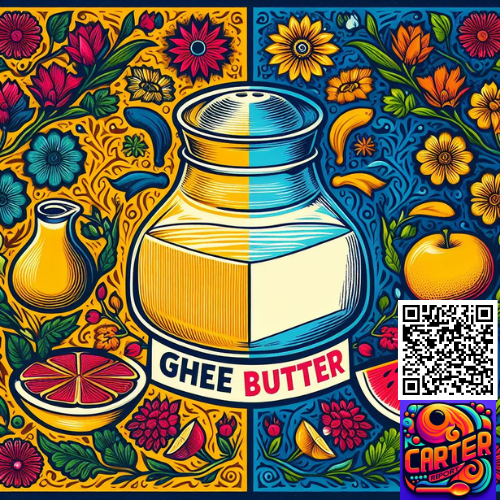Today we compare Dairy’s golden wonders; ghee and butter.
Ghee, the liquid gold of dairy. A rich and aromatic essence. Luxurious, versatile. A culinary treasure with ancient roots. Then, Butter. The creamy classic. A rich and indulgent delight. Familiar, beloved. A kitchen staple in households worldwide.
Nutrition? The battleground of richness. Fats, vitamins, flavor—the essence of indulgence. Each spread, a celebration of richness. Each dollop, a taste of luxury.
Flavor? A symphony of richness. Ghee, nutty and aromatic. A golden melody with hints of toasted goodness. Butter, creamy and indulgent. A velvety symphony with notes of sweetness and saltiness.
Culinary applications? A canvas of culinary decadence. Ghee, the liquid gold of flavor. Ideal for frying, sautéing, or adding richness to dishes—its versatility knows no bounds. Butter, the creamy classic. Spread on toast, melted over vegetables, or whipped into frosting—each use adds a touch of indulgence to meals.
This isn’t merely a clash of dairy options. It’s a tale of richness and indulgence. A narrative of nutty aromas and creamy textures. Each spread, a character in the culinary saga. Each dish, a chapter in the culinary chronicle.
Comparison Table
| Aspect | Ghee | Butter |
|---|---|---|
| Texture | Smooth, creamy, liquid at room temperature | Creamy, solid at room temperature |
| Flavor | Rich, nutty, aromatic | Creamy, slightly sweet, salty |
| Composition | Pure butterfat with milk solids and water removed | Emulsion of water, milk proteins, and butterfat |
| Smoke Point | Approx. 450°F (232°C) | Approx. 350°F (177°C) |
| Storage | Long shelf life, no refrigeration required | Refrigeration recommended to prevent spoilage |
| Usage | Cooking, frying, sautéing, baking, flavoring | Cooking, baking, spreading, flavoring |
| Health Benefits | Contains fat-soluble vitamins, may support digestion and immune health | Source of fat-soluble vitamins, may promote brain health and hormone balance |
🧈 Ghee: Liquid Gold
- Texture: Smooth, creamy, liquid at room temperature, perfect for cooking and flavoring.
- Flavor: Rich, nutty, aromatic, enhancing the taste of dishes with its golden essence.
- Usage: Ideal for cooking, frying, sautéing, baking, or simply drizzling over dishes for a touch of luxury.
🧈 Butter: Creamy Classic
- Texture: Creamy, solid at room temperature, versatile for spreading, cooking, and baking.
- Flavor: Creamy, slightly sweet, salty, adding richness to dishes with its velvety goodness.
- Usage: Enjoyed in cooking, baking, spreading, or simply melting over dishes for added flavor.
🥣 Culinary Delights
- Ghee: Enhances the flavors of spices in Indian cuisine, adds richness to baked goods, and elevates the taste of roasted vegetables.
- Butter: Essential for baking flaky pastries, creating creamy sauces, or simply spreading on warm bread for a comforting treat.
🌱 Nutritional Benefits
- Ghee: Contains fat-soluble vitamins like A, E, and K, may support digestion and immune health.
- Butter: Source of fat-soluble vitamins like A, D, E, and K, may promote brain health and hormone balance.
🛒 Shopping Tips
- Look for organic, grass-fed ghee for the highest quality and flavor.
- Choose unsalted or salted butter based on your preference and recipe requirements.
👩🍳 Cooking Tips
- Use ghee for high-heat cooking like stir-frying or sautéing, as it has a higher smoke point than butter.
- Experiment with different types of butter, such as cultured or clarified, to enhance the flavors of your dishes.
🧀 Cultural and Culinary Significance
- Ghee: Integral to Indian cuisine, used in traditional dishes like curries, dals, and sweets.
- Butter: Ubiquitous in Western cuisine, featured in classics like pastries, sauces, and comfort foods.
Dive into Q&A
🥣 Q1: Can I use ghee instead of butter in baking? 👩🍳 A1: Yes, ghee can be substituted for butter in baking with adjustments for texture and flavor.
🥣 Q2: Is ghee suitable for lactose-intolerant individuals? 👩🍳 A2: Ghee contains minimal lactose and may be tolerated by some lactose-intolerant individuals, but it’s best to consult a healthcare professional.
🥣 Q3: Can I make my own ghee at home? 👩🍳 A3: Absolutely, homemade ghee can be made by simmering butter until the milk solids separate and are removed, leaving behind pure butterfat.
🥣 Q4: What is clarified butter, and how does it differ from ghee? 👩🍳 A4: Clarified butter is similar to ghee but is simmered for a shorter time, resulting in a milder flavor and lower smoke point compared to ghee.
🥣 Q5: Can I use ghee or butter for skincare? 👩🍳 A5: Both ghee and butter contain moisturizing properties and can be used in homemade skincare products like creams and balms.
🥣 Q6: Can I use flavored ghee or butter in cooking? 👩🍳 A6: Yes, flavored ghee or butter infused with herbs, spices, or citrus zest can add depth and complexity to your dishes.
🥣 Q7: Are there vegan alternatives to ghee and butter? 👩🍳 A7: Yes, vegan butter substitutes made from oils or plant-based ingredients are available for those following a vegan lifestyle.
🥣 Q8: Can ghee or butter be used for frying? 👩🍳 A8: Both ghee and butter have high smoke points and are suitable for frying, though ghee is preferable for high-heat cooking due to its higher smoke point.
🥣 Q9: Can I use ghee or butter for popcorn? 👩🍳 A9: Absolutely, both ghee and butter can be drizzled over popcorn for a rich and indulgent snack.
🥣 Q10: Can I store ghee or butter at room temperature? 👩🍳 A10: Ghee can be stored at room temperature for extended periods due to its low moisture content, while butter is best kept refrigerated to prevent spoilage.

